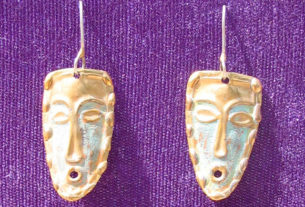During her heyday from the 1920s to the 1930s, unconventional artist Carmen Mondragón was demonized in much the same way as the fire-breathing creature of legends past. A defiant voice in the midst of a repressive era, she was mischaracterized as a madwoman and even a witch. So pervasive were these falsehoods that even after she faded from the limelight, it was difficult to disentangle Mondragón’s real story from the lore surrounding her.
It has only been in the past decade or so that Mondragón’s life has been reexamined and the myths dispelled. In recent years, she has been heralded for the role she played in her country’s history: both as a figure in the art scene of the 1920s and as an uninhibited woman who paved the way for female liberation in Mexico.
Born at her parents’ home in the Tacubaya district of Mexico City on July 8, 1893, Carmen was the fifth offspring of General Manuel Mondragón and Mercedes Valseca, who had a total of eight children. The military activities of General Mondragón, who specialized in artillery design, would lead the family to live in Europe on two occasions: once on a mission to France ordered by then-president Porfirio Díaz and later as a result of Mondragón’s exile from Mexico after his involvement in the violent uprising known as la Decena Trágica. Perhaps this uprooting of the family from Mexico to Europe planted the seeds of individualism in a young Carmen Mondragón, who would later disregard the social norms of a conservative Mexican society.
During the family’s stay in France from 1897 to 1905, the young Mondragón’s prose made such an impression on one of her schoolteachers that the woman appeared years later in Mexico to bestow some of Carmen’s old notebooks upon her former pupil. The preserved texts would appear in 1924 as the book A dix ans sur mon pupitre (From my desk, at 10 years old). These early writings of Mondragón reveal much about her intellect, as even at the tender age of 10, she had already begun writing about the oppressive destiny she stood to inherit as a woman and had come to the realization that she would never be understood by the world around her.
Even marriage at a young age did little to stifle Mondragón’s unrestrained spirit. On August 6, 1913, 20-year-old Mondragón wedded Manuel Rodríguez Lozano, a military cadet who attended the same Colegio Militar from which Mondragón’s father had graduated. That same year, Manuel Mondragón was exiled to Europe and was accompanied by all family members except Carmen and her husband, who traveled to Paris, France soon after.
Little has been written about this period of Mondragón’s life, but it is widely believed that she and Rodríguez Lozano met some of the most influential artists of the 20th century while in France, including Pablo Picasso and Diego Rivera. Thus, it was in Europe that Mondragón seemingly had her first taste of the bohemian existence, which would come to dominate her life less than a decade later.
After their stay in France, Rodríguez Lozano and Mondragón moved in with her extended family in San Sebastián, Spain. There, Carmen’s brother Manuel ran his own photography studio and her sister-in-law Guadalupe wrote plays. The creativity extended to Carmen and her husband, as they both began painting on a regular basis during the family’s exile in Spain. This period commenced a lifelong involvement with art for the pair, who both went on to become notable figures in Mexico’s creative community.
Most members of the Mondragón family reestablished themselves in Mexico in 1921, including Carmen and Manuel Rodríguez Lozano. This year marked a new chapter in Mondragón’s life, as she reunited with her home country, liberated herself from marriage and ignited a relationship with one of Mexico’s most famed painters.
Upon their return to Mexico, Carmen and Manuel went their separate ways. And although it is not clear whether or not they ever divorced, the couple never lived together again.
Nahui Ollin
It was around this same time that Mondragón encountered the notorious artist and writer Gerardo Murillo, more commonly known as Dr. Atl. The two embarked on a journey of passion and creativity together, albeit in a relationship that was also marred by violence and scandal. Mondragón and Dr. Atl lived together in the ex Convento de la Merced (former Mercy Convent) in Mexico City, where their tempestuous union resulted in a prolific artistic period for both of them. During this time, Mondragón published two works of her poetry entitled Óptica cerebral, poemas dinámicos (Cerebral perspective, dynamic poems) and Calinement je suis dedans (I am tender inside).
Throughout her relationship with Atl, Mondragón also produced a significant number of paintings in her unstudied technique that has since been categorized as in the style of naïf or naive art. Most art critics agree that a concise definition of the naïf genre does not exist, although many point to shared characteristics such as a flattened perspective, the inclusion of vibrant colors, a focus on quotidian themes, and the employment of an instinctual style that flows from an untrained, yet skilled, hand.
Indeed, Mondragón’s paintings incorporate all of the elements listed above, although she never labeled herself a naïf artist. Depictions of rural life are wrought out more through the use of color than elaborate detail in Mondragón’s works of art. Through her eyes, we are introduced to the traditions, people and landscapes that formed the Mexican pueblos of her era, as well as the friends and lovers that surrounded her, and finally, Mondragón herself. Though many of Mondragón’s published paintings are undated, there appears to be a continuity in regard to form and subject matter that spans the entire course of her work. It is a testament to her singular spirit that Mondragón’s style remained true to her own inherent manner of painting, despite her exposure to artists such as Rodríguez Lozano, Atl and others. In fact, Mondragón herself characterized her painting as intuitive.
Among the most powerful of Mondragón’s pieces are the ones in which she captured herself on canvas. A striking beauty, her luminous green eyes were the focal point of her face. And in all of Mondragón’s self-portraits, those sparkling pools of green take command of the canvas, standing out even against the colorful backdrops of her paintings.
Those enchanting green eyes were not only immortalized by Mondragón, but also by an assorted bevy of painters for whom she modeled in the 1920s, including Roberto Montenegro, Diego Rivera and of course, Dr. Atl. Mondragón’s fiery charm was caught on film as well, with the glint of her unabashed sensuality recorded in Edward Weston’s portraiture and Antonio Garduño’s nude series of her.
With a spirit as fierce as her beauty, Mondragón proved to be a volatile match for Atl and the pair broke up by the mid-1920s. Atl bestowed her with a lasting gift, however, as he christened her with a new name: Nahui Olin. She embraced the pseudonym and thus, it became as much a part of her identity as her birth name.
The name Nahui Olin seems a fitting one for this uninhibited and charismatic woman, as it is a complex phrase that relates to the cosmic forces of the universe. According to the online dictionary Aulex, nahui means four, whereas a variation of olin (spelled ollin) is defined as earthquake, constant movement, and a day in the Aztec calendar that symbolizes the sun’s humanity and the earth’s movement. Online analyses of the Aztec calendar describe Nahui Olin as the earthquake’s sun or the fifth epoch of the solar age that will result in the extinction of the human race. According to Mondragón’s own writings, Nahui Olin is a cosmogonic name that signifies the strength and the power of the movements that emit light, life and force.
Mondragón seemed to personify the characteristics associated with Nahui Olin, as she exuded energy, strength and audaciousness. She refused to play the role of a submissive female that was foisted upon many women of this era. As a result, Mondragón was often described as a madwoman. Yet, she brushed aside these disparaging judgments and remained a nonconformist throughout her life.
Later Years
Mondragón escaped Mexico for a time in the 1930s, due to her relationship with ship captain Eugenio Agacino. The painter documented their travels through her art, utilizing her signature vivid brushstrokes to chronicle their shared adventure and amour. During this time, Mondragón’s destinations included Cuba, Spain and France. She would not be free of Mexico for long, however, as Agacino died in 1934 and Mondragón returned to life in her native country. Mondragón continued to paint and write after Agacino’s death, but never again did she find the love that had blessed her for those few years in the 1930s.
In her later years, Mondragón adopted a solitary life, trading in the raucous parties and bold antics of her past for an obscure existence, surrounded by the cats and dogs who had become her dearest companions. In the 1950s, she taught drawing at an elementary school and at some point, moved back into the house where she had been born. Even in old age, however, Mondragón retained her unbridled personality, as she talked openly about such unusual subjects as her friendship with the sun. Some say that she was consumed by madness at the end of her life, but others who knew her personally have attested to her lucidity.
On January 23, 1978, Mondragón died in her childhood home, leaving behind a world that had tried to forget her. However, her story did not end there. Now appreciated as a woman ahead of her time, she has been featured as the subject of books, movies and even a retrospective exhibit held from December 1992 to March 1993 in Mexico’s Museo Estudio Diego Rivera. Feared, ridiculed and marginalized while she lived, the brazen voice of Mondragón could not be quieted even by death.
SOURCES
- Nahui Olin: la mujer del sol by Adriana Malvado
- ‘Nahui Ollín’, una mujer que desafía a su época: Sylvia Pasquel, Notimex, June 24, 2004
- Desafió Nahui Olin la doble moral porfirista, Cimacnoticias.com, February 18, 2003
- Nahui Olin al desnudo by Guillermo Samperio, Siempre!, March 7, 2001
- nahui hollín by Esther López-Portillo, sepiensa.org.mxPublished or Updated on: December 1, 2005


